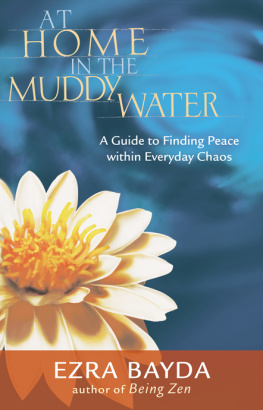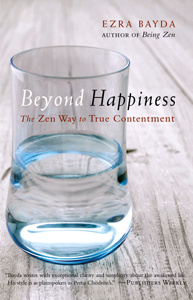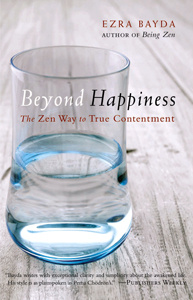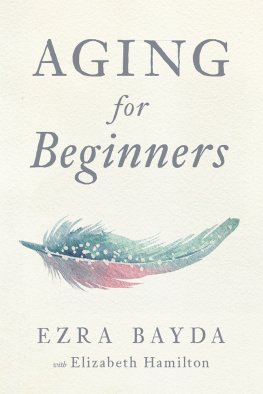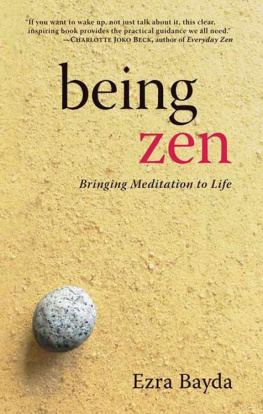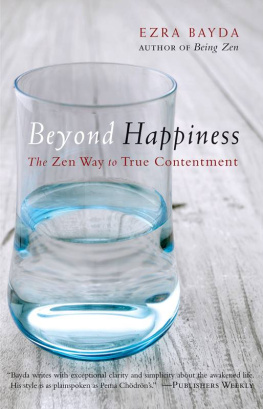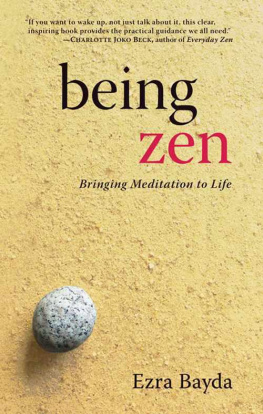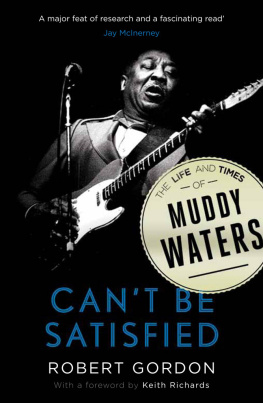Ezra Bayda provides real, specific advice for extending our spiritual practice beyond the mediation cushion. This is a major contribution to contemporary dharma.
Larry Rosenberg, author of Breath by Breath and Living in the Light of Death
ABOUT THE BOOK
May we exist like a lotus, / At home in the muddy water. / Thus we bow to life as it is.
This verse is an important reminder, says Ezra Bayda, of what the spiritual life is truly about: the willingness to open ourselves to whatever life presentsno matter how messy or complicated. And through that willingness to be open, we can discover wisdom, compassion, and the genuine life we all want. In At Home in the Muddy Water, Bayda applies this simple Zen teaching to a range of everyday concernsincluding relationships, trust, sexuality, and moneyshowing that everything we need to practice is right here before us, and that peace and fulfillment is available to everyone, right here, right now, no matter what their circumstances.
EZRA BAYDA teaches at Zen Center San Diego. He is also the author of Being Zen, Saying Yes to Life (Even the Hard Parts), and Zen Heart. For more information, visit www.zencentersandiego.org.
Sign up to learn more about our books and receive special offers from Shambhala Publications.

Or visit us online to sign up at shambhala.com/eshambhala.

A Guide to Finding Peace within Everyday Chaos
Ezra Bayda

SHAMBHALA
Boston & London
2012
Shambhala Publications, Inc.
Horticultural Hall
300 Massachusetts Avenue
Boston, Massachusetts 02115
www.shambhala.com
2003 by Ezra Bayda
Cover art and design by Jim Zaccaria
All rights reserved. No part of this book may be reproduced in any form or by any means, electronic or mechanical, including photocopying, recording, or by any information storage and retrieval system, without permission in writing from the publisher.
The Library of Congress catalogues the previous edition of this work as follows:
Bayda, Ezra.
At home in the muddy water: a guide to finding peace within everyday chaos Ezra Bayda.
p. cm.
eISBN 978-0-8348-2330-3
ISBN 978-1-59030-168-5 (paper)
ISBN 978-1-57062-947-1 (cloth)
1. Spiritual lifeZen Buddhism.
2. CompassionReligious aspectsBuddhism. I. Title.
BQ9288.B39 2003
294.3444dc21 2002013960
All I can experience and work with is what my life is right now. Thats all I can do.The rest is the dream of ego.
Charlotte Joko Beck
Contents
THIS BOOK IS A CONTINUATION of my first book, Being Zen. In a way, they make up one book; together the two present a particular approach to waking up from the self-centered dream we all live in.
I wish to acknowledge the same people I thanked in Being Zenparticularly my teacher, Joko Beck, for her clarity and precision; and also Stephen Levine and Pema Chdrn, for their emphasis on bringing practice to the heart.
Thanks to Carolyn Miller for the initial typing and editing of the manuscript; and to my daughter Jenessa for her thorough editing. The final editing was skillfully done by Emily Hilburn Sell, who did an excellent job clarifying what I was trying to say.
And last, I am continuously thankful to Elizabeth Hamilton, my wife, friend, and teacher, not only for her aspiration and keen intellect, but also for her irrepressible good cheer and wholehearted support.
WHEN MY WIFE, ELIZABETH, and I were in Paris, we saw a large billboard in the subway station that read Soyez Zen. Literally, this means Be Zen. It could be interpreted more generally as Just Live or Appreciate the Sweetness of the Moment. Although the billboard was only an advertisement for futons, it made me realize how often we forget that practice is actually about living, about opening into whatever life presents. Isnt it true that we tend instead to equate spiritual practice with a particular technique, such as sitting in meditation, or with feeling a particular way, such as calm or centered?
Recently I gave a talk to a group of young adults, most in their twenties. I was amazed how easily they could articulate ideas about practice, such as the importance of letting life be, or of not trying to fix or change things. It was not that their stated views were inaccurate. What amazed me was that they discussed these things so casually, as if they could really live them. Yet making practice real is much more difficult than simple intellectual understanding. Anyone who has practiced for a while knows that the greatest barrier to waking up is that we dont realize how asleep we are. It takes more than reading books, hearing lectures, or meditating for a short while to understand how difficult practice really is.
If we dont begin to know ourselves, we cannot, as the saying goes, see the way even as we walk on it. Knowing ourselves allows us to see what prevents us from opening into Soyez Zenjust living. It allows us to see in what way and to what degree we are stuck in the mud, knee-deep in our galoshes.
During Zen meditation retreats, theres a verse thats recited after each meal:
May we exist like a lotus
At home in the muddy water.
Thus we bow to life as it is.
What does it mean to be at home in the muddy water? What does it mean to bow to life as it is? The answers to these questions are what this book is aboutclarifying the confusion of daily living, cultivating equanimity even within the high-speed messiness of life, and transforming our everyday suffering into the genuine life that all of us want. This entails knowing ourselves and all the ways we hold ourselves back in fear.
These things are not easy, but they are possible. My intent in writing this book is to communicate, as practically and specifically as possible, how to make the genuine life a lived reality. Using topics such as relationships, trust, sexuality, and money, the emphasis is on ways to become willing to Soyez Zen, to just be, right in the middle of life. To do this, we must see the endless ways we keep ourselves stuck in the mud of our spinning minds, our habitual and protective patterns, and, of course, our fears.
If we decline this opportunity and continue to hold back in fear and protectedness, wont that bring about our deepest regret? We must take these words to heart, so that we can awaken to the basic kindness and connectedness that are the essential nature of our Being.
PART ONE
A ZEN STUDENT walked in to see the master. Sitting down, he blurted out, Theres something terribly wrong with me! The master looked at him and asked, Whats so wrong? The student, after a moments hesitation, responded, I think Im a dog. To that the master responded, And how long have you thought that? The student replied, Ever since I was a puppy.
What does this story have to do with spiritual practice? Everything! It puts the basic human problem in a nutshell. The next time you find yourself immersed in the drama of a strong emotional reaction, awash with deeply believed thoughts, ask yourself how long youve taken these thoughts to be the truth. Especially notice the ones you believe the most: Life is too hard. No one will ever be there for me. Im worthless. Im hopeless. How long have you believed these thoughts? Ever since you were a puppy!
Next page
